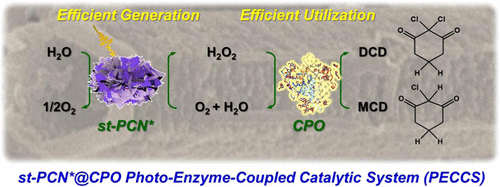当前位置:
X-MOL 学术
›
ACS Catal.
›
论文详情
Our official English website, www.x-mol.net, welcomes your feedback! (Note: you will need to create a separate account there.)
Granum-Inspired Photoenzyme-Coupled Catalytic System via Stacked Polymeric Carbon Nitride
ACS Catalysis ( IF 11.3 ) Pub Date : 2021-07-09 , DOI: 10.1021/acscatal.1c01555 Jingshan Jia 1, 2 , Qian Huo 1, 2 , Dong Yang 2, 3 , Yiying Sun 1, 2 , Songping Zhang 4 , Shihao Li 1, 2 , Jiafu Shi 2, 3, 5 , Zhongyi Jiang 1, 2, 5
ACS Catalysis ( IF 11.3 ) Pub Date : 2021-07-09 , DOI: 10.1021/acscatal.1c01555 Jingshan Jia 1, 2 , Qian Huo 1, 2 , Dong Yang 2, 3 , Yiying Sun 1, 2 , Songping Zhang 4 , Shihao Li 1, 2 , Jiafu Shi 2, 3, 5 , Zhongyi Jiang 1, 2, 5
Affiliation

|
Photoenzyme-coupled catalysis has become a powerful platform for chemical manufacturing, in which energy-bearing intermediates are often shuttled between a photocatalytic module and an enzymatic module. A photoenzyme-coupled catalytic system (PECCS) to realize the generation of intermediates by the photocatalytic module and utilization of intermediates by the enzymatic module is highly desired. Inspired by the structure and function of a granum, stacked tubular polymeric carbon nitride (st-PCN*) is designed as both a photocatalyst and a carrier for chlorperoxidase (CPO), constructing the st-PCN*@CPO PECCS to implement the cascade chlorination reaction. st-PCN* ensures oriented electron transfer, achieving the H2O2 evolution rate of 150 μmol h–1 g–1 (st-PCN*), over 55- and 2-fold that of bulky PCN (b-PCN) and bulky PCN* (b-PCN*). Meanwhile, st-PCN* shortens the diffusion distance of H2O2 from st-PCN* to CPO. Under simulated sunlight irradiation, our st-PCN*@CPO PECCS realizes in situ, continuous, and controllable supply of H2O2 to CPO, followed by converting monochlorodimedone (MCD) into dichlordimedone (DCD) with a final conversion ratio of ∼39.5%. The initial reaction rate could reach 0.29 mM h–1, over 20-fold that of its counterpart PECCS with a nonstacked structured photocatalyst. Our study unveils the potential of exploring the stacked structure to coordinate cascade catalytic processes.
中文翻译:

通过堆叠聚合氮化碳的颗粒启发光酶偶联催化系统
光酶偶联催化已成为化学制造的强大平台,其中承载能量的中间体通常在光催化模块和酶模块之间穿梭。非常需要一种光酶偶联催化系统(PECCS),以实现光催化模块产生中间体和酶模块利用中间体。受颗粒结构和功能的启发,将堆叠管状聚合氮化碳 ( st -PCN*) 设计为光催化剂和氯过氧化物酶 (CPO) 的载体,构建st -PCN*@CPO PECCS 以实现级联氯化反应。st -PCN* 确保定向电子转移,实现 H 2O 2演化速率为 150 μmol h –1 g –1 ( st -PCN*),是大体积 PCN ( b -PCN) 和大体积 PCN* ( b -PCN*) 的55倍和 2 倍。同时,st -PCN* 缩短了H 2 O 2从st -PCN* 到CPO的扩散距离。在模拟阳光照射下,我们的st -PCN*@CPO PECCS实现了原位、连续、可控的H 2 O 2供应转化为 CPO,然后将一氯二甲酮 (MCD) 转化为双氯二甲酮 (DCD),最终转化率约为 39.5%。初始反应速率可达到 0.29 mM h –1,是具有非堆叠结构光催化剂的对应 PECCS 的 20 倍以上。我们的研究揭示了探索堆叠结构以协调级联催化过程的潜力。
更新日期:2021-08-07
中文翻译:

通过堆叠聚合氮化碳的颗粒启发光酶偶联催化系统
光酶偶联催化已成为化学制造的强大平台,其中承载能量的中间体通常在光催化模块和酶模块之间穿梭。非常需要一种光酶偶联催化系统(PECCS),以实现光催化模块产生中间体和酶模块利用中间体。受颗粒结构和功能的启发,将堆叠管状聚合氮化碳 ( st -PCN*) 设计为光催化剂和氯过氧化物酶 (CPO) 的载体,构建st -PCN*@CPO PECCS 以实现级联氯化反应。st -PCN* 确保定向电子转移,实现 H 2O 2演化速率为 150 μmol h –1 g –1 ( st -PCN*),是大体积 PCN ( b -PCN) 和大体积 PCN* ( b -PCN*) 的55倍和 2 倍。同时,st -PCN* 缩短了H 2 O 2从st -PCN* 到CPO的扩散距离。在模拟阳光照射下,我们的st -PCN*@CPO PECCS实现了原位、连续、可控的H 2 O 2供应转化为 CPO,然后将一氯二甲酮 (MCD) 转化为双氯二甲酮 (DCD),最终转化率约为 39.5%。初始反应速率可达到 0.29 mM h –1,是具有非堆叠结构光催化剂的对应 PECCS 的 20 倍以上。我们的研究揭示了探索堆叠结构以协调级联催化过程的潜力。







































 京公网安备 11010802027423号
京公网安备 11010802027423号